A concise report of the development of the flora
II. Carboniferous and Early Permian |
|
During the Carboniferous (about 355 - 295 millions years ago) the flora underwent a huge development. That was probably a consequence of the profitable growing circumstances. There was a warm and humid climate on nearly all continents. Never in Earth history have there been more woods than in the second half of the Carboniferous. Even Antarctica was covered with trees. Not until the end of the Carboniferous it became colder.
Plant fossils from the Lower Carboniferous are not common. There are
some places in Scotland where they can be found, like
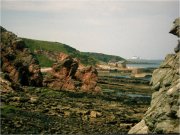 along
the coast near Edinburgh (click photo on the right). In the Upper
Carboniferous, however, a wealth of plant fossils occur near the coal seams.
Why this difference between the Lower and the Upper Carboniferous?
along
the coast near Edinburgh (click photo on the right). In the Upper
Carboniferous, however, a wealth of plant fossils occur near the coal seams.
Why this difference between the Lower and the Upper Carboniferous?
The reason is that during the Late Carboniferous very extensive, long existing,
swamps were formed in large parts of 'Europe' and other continents. Peat
layers developed, which were turned into coal seams under the pressure in
the Earth's crust later on. From time to time these swamps were flooded,
causing the immersion of the living plants with mud and so they could fossilize.
That's why one finds the plant layers just above the coal seams. In the Piesberg
near Osnabrück this is very well visible. Just below the coal seams
are the root layers with the remains of the roots of the trees growing in
the 'coal swamp'.
These swamps occurred much less frequently in the Early Carboniferous and
during that time fossilization mainly took place in rivers and deltas. In
this case the plants had been transported over a long distance already and
were strongly damaged before fossilizing.
There is an abundance of plants around the coal seams.
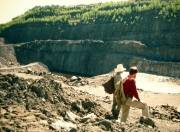
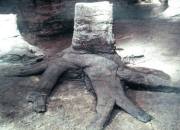 Sadly enough the methods of winning are not fossil-friendly
anymore and many of the coal mines have been closed down. Fossils from the
coal seams can still be found (e.g.) in and near the Piesberg , Germany
(click photo left), at Ibbenbüren, Germany (where the coal
is mined at a depth of 1400 m and where the stone is deposited on a waste
heap), near Eygelshoven, Netherlands (where an old waste heap is digged away)
and at different places in Belgium (e.g. near Charleroi). In Glasgow one
can admire stumps with roots of ancient clubmoss trees in the Victoriapark
(click photo on the right).
Sadly enough the methods of winning are not fossil-friendly
anymore and many of the coal mines have been closed down. Fossils from the
coal seams can still be found (e.g.) in and near the Piesberg , Germany
(click photo left), at Ibbenbüren, Germany (where the coal
is mined at a depth of 1400 m and where the stone is deposited on a waste
heap), near Eygelshoven, Netherlands (where an old waste heap is digged away)
and at different places in Belgium (e.g. near Charleroi). In Glasgow one
can admire stumps with roots of ancient clubmoss trees in the Victoriapark
(click photo on the right).
Common fossils are parts of clubmoss trees (roots, pieces of bark, axes with
foliage, spore cones), or horsetail trees (ditto) , seed ferns and ferns,
herbal clubmosses (Sphenophyllum) and Cordaites, an ancestor
or a relative of the recent conifers. Identifying the finds is not easy,
but there are good books for this purpose (e.g. Cleal & Thomas: Plant
fossils of the British Coal Measures).
Of course numerous small animals were living in the coal swamp, but they
had only a tiny chance to fossilize. That's why fossils of these spider-like
animals, myriapodes, insects and xiphosurids are extremely scarce. Click
here to see fossils of
these small animals.
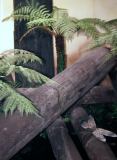 |
Especially the clubmosses did very well: the clubmoss trees,
like Sigillaria and Lepidodendron, could reach a height of
more than 30 m (click photo on the left). The horsetail trees
(Calamites, click photo on the right) also had their
'flowering' time. They could reach a size up to 20 m. Horsetails are easily recognizable having leaves sitting in whorls. At such a whorl there was a diafragm in the stem, also called a node. The diafragms divided the branches and trunks in compartments, just like in the still living horsetails. Click on the photos to see photos of leaflets, bark and cones of these plants. More information on Sigillaria, Lepidodendron and Calamites. |
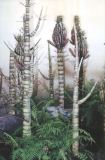 |
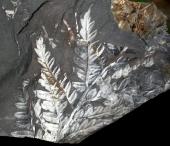 |
Furthermore many seed ferns occurred (click photo on
the left). These are gymnospermous plants with fern-like leaves. They
are often difficult to distinguish from the real ferns (sporing plants)
because of the resemblance of the fronds. The seeds formed by the seed ferns
are found nearly always detached from the leaves. An attached seed is a great
rarity! In some of the fossils of real ferns the clusters of sporangia can
be seen as small projections or holes (click photo on the
right). Both seed ferns and real ferns were in many cases trees. Click here for an identification table of ferns and seed ferns from the Piesberg and Ibbenbüren. |
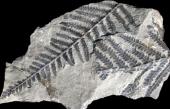 |
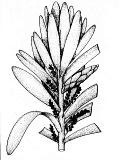 |
An important tree in and near the coal swamp was Cordaites. It had long, ribbonlike leaves, wich could be up to 75 cm long . Some species formed a kind of mangrove forest, others grew in dryer places. Mostly fragments of the leaves are found. Cordaites was one of the highest developed plants in the late Carboniferous. It was a gymnosperm related to the still living conifers. During many years Cordaites has been thought to be a direct ancestor of the conifers, but probably Cordaites and the conifers had a common ancestor. Click here for more information on Cordaites. |  |
At the end of the Carboniferous the tree-shaped clubmosses and horsetails
declined, mainly because the swamps were disappearing and because it became
colder on Earth. Still there were some coal swamps in the earliest part of
the Permian, like near Manebach in Thüringen (Germ.). In that region
coal seams combined with plant layers and root layers have been formed in
the same way as in the Carboniferous.
But very soon in the Permian the circumstances started to change ...